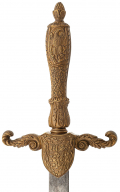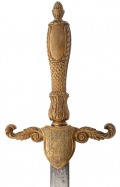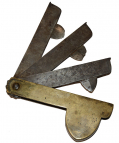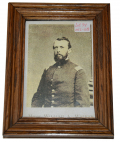site search
online catalog
PRESENTATION M1840 MEDICAL STAFF SWORD OF JOHN T. WALKER, 25th INDIANA, PRAISED IN OFFICIAL REPORTS FOR ACTIONS AT FORT DONELSON AND SHILOH

$3,800.00 SOLD
Quantity Available: None
Item Code: 1052-1128
This sword is an interesting version of the US Model 1840 Medical Staff sword and has a great presentation on the obverse langet by the commissioned officers of the 25th Indiana to Surgeon John T. Walker. Walker served with the regiment from its organization in 1861 to mid-1864 and was praised by the regiment’s Colonel for his conduct at Fort Donelson and Shiloh where he went into action with regiment to treat the wounded as they fell. Of Ft. Donelson the Colonel reported: “The conduct of the Surgeon and Assistant Surgeon is esteemed worthy of especial mention. Assistant Surgeon Arthur White devoted himself to relieving the wants of the wounded and suffering at the hospital, while Principal Surgeon, Dr. John T. Walker, followed the regiment to the field and received the wounded as they fell in the fight.” At Shiloh, the Assistant Surgeon was again posted to the field hospital while Walker and the regiment’s Chaplain went into action with the men: “Surgeon Walker and Chaplain Heuring were in the hottest part of the field, active in their work of attention to the wounded.”
Walker’s sword has the standard, regulation, ornate small-sword style gilt brass hilt for the US M1840 Medical Staff sword, a pattern derived from Virginia presentation swords of the 1830s and worn throughout the Civil War. The hilt, looking somewhat like the Ames pattern, is cast and chased with oak leaves, vines, flower petals, and acanthus leaves, with an elongated US eagle with arrows and olive branch in a tall oval on the obverse near the pommel, with the oval left blank on the reverse, with the hilt capped by a pineapple-shaped nut securing the blade tang. The crossguard has scrolled quillons cast and chased with leaf designs, and shield-shaped langets, with the obverse cast with an Old English “MS” (for Medical Staff,) over thirteen stars, all within a draped wreath. On the reverse the oval, which might suffice for an inscription, was left blank and the engraving done lengthwise on the langet, a wise choice since engraving on the grip would get worn from handling. The inscription reads: “Presented to/Dr. J.T. Walker/1st Surg. 25th Regt. Ind. Vols./BY THE/Commissioned Officers as/a testimony of respect.”
The term “1st Surgeon” mirrors the clarification of Walker’s status in the Fort Donelson official report not only as “Surgeon” but as “Principal Surgeon.” It may have taken some time for Indiana to catch up with US Army terminology. We note that Walker was finally given a Major’s commission, the appropriate rank for a regimental surgeon on Jan. 28, 1863.
The blade is straight, double-edged, with spearpoint, oval in cross-section, but is unusual in having a narrow central fuller. We see no maker marks, but the ricasso is long and flat, indicating an import. The blade is etched on both sides with floral and patriotic motifs. The central motif on the reverse is an eagle with upraised wings. On the obverse “Medical Staff” is etched in a thin script. The scabbard is steel, rather than gilt brass, but mounted with gilt brass throat, upper and lower carrying ring mounts and long drag. It is set up with two upper rings and one lower ring, typical of Medical Staff swords. The mounts are plain on the reverse, and cast and chased on the obverse. The upper and middle mounts show twelve-pointed stars typical of MS swords, one on the upper mount and two on the middle, with a leafy branch between, with a long oakleaf branch on the boot drag, with all the elements on a nicely stippled ground, and the drag showing wide lyre-shaped wings at the top in addition to the drag blade. The upper mount has a small “83” stamped on the reverse, likely the dealer’s or assembler’s stock code.
The condition overall is very good. The casting and chasing of the hilt and scabbard mounts is detailed and the brass hilt has an uncleaned, mellow, golden mustard tone. The brown finish of the scabbard body is strong and there are no dents or dings. The etching is visible, though a bit soft, with the blade medium bright, but showing some stains and freckling on the upper half. The scabbard mounts show some minor age spotting on the reverse. The sword is accompanied by a three-bladed fleam, in its original leather pouch. One of the blades engraved in script, John Walker. This likely comes from his earlier medical practice.
John T. Walker (1816-1865) was born in New Jersey, attended Ohio Medical College, and had prior military service in the Mexican War as Assistant Surgeon of the 2nd Indiana from July 14, 1846, to June 30, 1847. He practiced medicine in Evansville, IN, in the 1850s. and enlisted at the beginning of the Civil War as Surgeon with the 25th Indiana, with his commission dating to Aug. 19, 1861. He is listed as commissioned a Major on Jan. 28, 1863, but as mentioned above this is likely retroactive paperwork making official the rank usually conveyed to a Regimental Surgeon. He served until resigning June 10, 1864, returned home to resume his practice, but died Feb. 8, 1865, according to one source from health problems acquired in the service. To that we might add grief. A son, William H. Walker had served with him as Adjutant of the 25th in 1861-1862, and later joined the 136th Indiana as Captain and then Lieutenant Colonel, but died in died in 1864.
During Walker’s service with the 25th it campaigned with Fremont and with Pope at Blackwater River in Missouri in December 1861, where he claimed to capture 1,300 Confederates while suffering just 10 casualties. Under Grant at the Battle of Fort Donelson they lost 16 killed and 80 wounded, with Walker praised in the Colonel’s official report as going into action with the regiment and treating casualties on the field, while the assistant surgeon tended to the field hospital. At Shiloh they lost another 27 killed and 122 wounded, and later were in the Siege of Corinth. In July and August 1862, they were at Memphis doing scouting and patrols against guerillas. In October they fought at the Hatchie River, losing 3 killed and 76 wounded and then served in northern Mississippi, with six of the companies seeing action at Davis Mill. They did provost duty at Memphis from January to November 1863, railroad guard duty until late January 1864, and were then on Sherman’s Meridian raid. The regiment reenlisted as veterans in February 1864 and were posted at Decatur, AL, until August, engaging periodically with Confederate cavalry. Walker tendered his resignation during this period. The regiment went on to see more action at Atlanta, Jonesboro, and elsewhere, mustering out in July 1865.
This sword has a great presentation and was carried by a Surgeon with some active service on the front lines. It would especially fit a medical collection or, needless to say, one focused on Indiana’s contribution to preserving the Union. [sr][ph:L]
~~~~~~~~~~~~~~~~~~~~~~~~~~~~~~~~~~~
THIS ITEM, AS WITH ALL OTHER ITEMS AVAILABLE ON OUR WEB SITE,
MAY BE PURCHASED THROUGH OUR LAYAWAY PROGRAM.
CLICK HERE FOR OUR POLICIES AND TERMS.
THANK YOU!
Inquire About PRESENTATION M1840 MEDICAL STAFF SWORD OF JOHN T. WALKER, 25th INDIANA, PRAISED IN OFFICIAL REPORTS FOR ACTIONS AT FORT DONELSON AND SHILOH
For inquiries, please email us at [email protected]
Most Popular
Historical Firearms Stolen From The National Civil War Museum In Harrisburg, Pa »
Theft From Gravesite Of Gen. John Reynolds »
Fine Condition Brass Infantry Bugle Insignia »
Selection Of Unframed Prints By Don Troiani »
Wonderful Condition Original Confederate-Manufactured Kepi For A Drummer Boy Or Child »
featured item
DAGUERROTYPE IN UNIFORM OF LEWIS HENRY LITTLE, BREVET FOR GALLANT AND MERITORIOUS CONDUCT AT MONTEREY 1846; KILLED IN ACTION AS CONFEDERATE BRIGADIER GENERAL AND DIVISION COMMANDER AT IUKA 1862
This very clear sixth-plate daguerreotype dates about 1850 and shows Lewis Henry Little, usually referred to by his middle name, as a Captain in the 7th U.S. Infantry. Born in Maryland in 1817, he was appointed 2nd Lieutenant in the 5th US Infantry… (1138-1808). Learn More »


















